Astronomical Distances
Measuring distances in astronomy
is difficult: we cannot simply take a metre stick and pace out the distance
to a star or galaxy. Instead we have to find indirect ways of estimating
the distance, from other quantities which can be measured directly.
A powerful method for estimating distances is the idea of a standard
candle - i.e. a particular type of star whose intrinsic brightness
is known, rather like knowing the wattage of a household light bulb. By
comparing the intrinsic brightness (or luminosity) with how
bright the star appears to be, one can estimate its distance.
Two examples of standard candles commonly used by cosmologists to measure
distances are Cepheids and Supernovae;
together with measurements of galaxy redshifts,
these distance estimates tell us a great deal about the distribution and
motions of galaxies - and the dynamics of the Universe itself.
Cepheids
Cepheids are variable stars which
pulsate regularly, 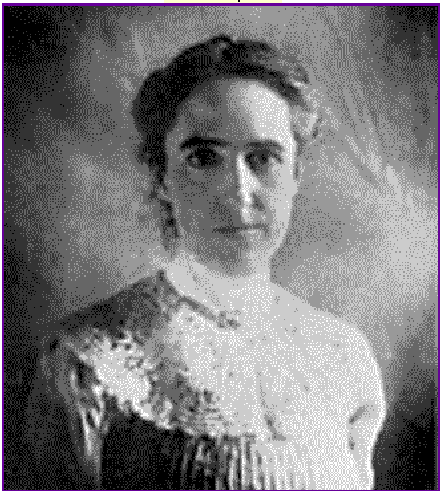 changing
their size and intrinsic brightness over a period ranging from a few days
to a few weeks. In the early 1900s Henrietta Leavitt
studied
changing
their size and intrinsic brightness over a period ranging from a few days
to a few weeks. In the early 1900s Henrietta Leavitt
studied 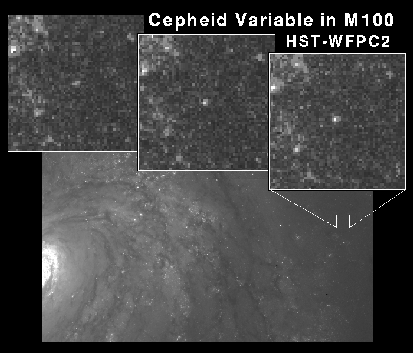 Cepheids
in the Large Magellanic Cloud (the small satellite
galaxy of the Milky Way) and found a relationship between their period
and the luminosity. This meant that, simply by measuring the period of
a more distant Cepheid, astronomers could immediately determine its luminosity
- and hence its distance. Now, almost a century later, Cepheids remain
the backbone of the cosmological distance scale. The Hubble
Space Telescope can observe Cepheids in galaxies many tens of millions
of light years away, such as the giant Spiral galaxy M100
in the Virgo Cluster. (The images below show some Cepheids in M100). During
the past decade the HST Distance
Scale Key Project has used Cepheids to map out our "Local Neighbourhood"
of the Universe.
Cepheids
in the Large Magellanic Cloud (the small satellite
galaxy of the Milky Way) and found a relationship between their period
and the luminosity. This meant that, simply by measuring the period of
a more distant Cepheid, astronomers could immediately determine its luminosity
- and hence its distance. Now, almost a century later, Cepheids remain
the backbone of the cosmological distance scale. The Hubble
Space Telescope can observe Cepheids in galaxies many tens of millions
of light years away, such as the giant Spiral galaxy M100
in the Virgo Cluster. (The images below show some Cepheids in M100). During
the past decade the HST Distance
Scale Key Project has used Cepheids to map out our "Local Neighbourhood"
of the Universe.
Supernovae
Even with the Hubble Space Telescope,
it is only possible to observe Cepheids  out
to a distance of about 100 million light years. Beyond this point cosmologists
need to find alternative methods to estimate galaxy distances. One such
method is another standard candle: a supernova. Supernovae
are massive stars which, as they reach the end of their lives, undergo
a cataclysmic explosion
out
to a distance of about 100 million light years. Beyond this point cosmologists
need to find alternative methods to estimate galaxy distances. One such
method is another standard candle: a supernova. Supernovae
are massive stars which, as they reach the end of their lives, undergo
a cataclysmic explosion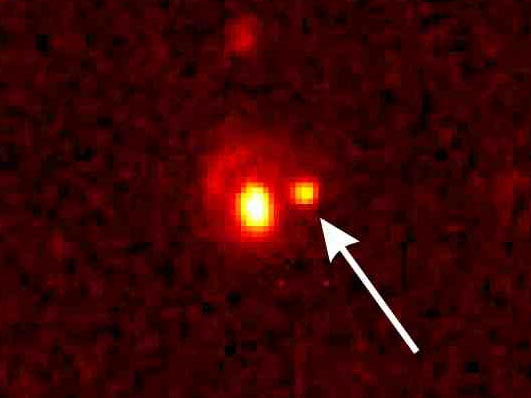 ,
making them almost as bright as entire galaxy. Cosmologists can now observe
supernovae in galaxies at distances of billions of light years; we are
seeing these exploding stars at a time when the Universe was less than
half its present age. Measuring galaxy distances with supernovae has helped
us to understand the past evolution - and even the future fate - of the
Universe (see below).
,
making them almost as bright as entire galaxy. Cosmologists can now observe
supernovae in galaxies at distances of billions of light years; we are
seeing these exploding stars at a time when the Universe was less than
half its present age. Measuring galaxy distances with supernovae has helped
us to understand the past evolution - and even the future fate - of the
Universe (see below).
Hubble's
Law and the Redshift
 In
the 1920s the American cosmologist Edwin Hubble (pictured here second from
the left) measured the distances and velocities of many nearby galaxies
using the 100
In
the 1920s the American cosmologist Edwin Hubble (pictured here second from
the left) measured the distances and velocities of many nearby galaxies
using the 100 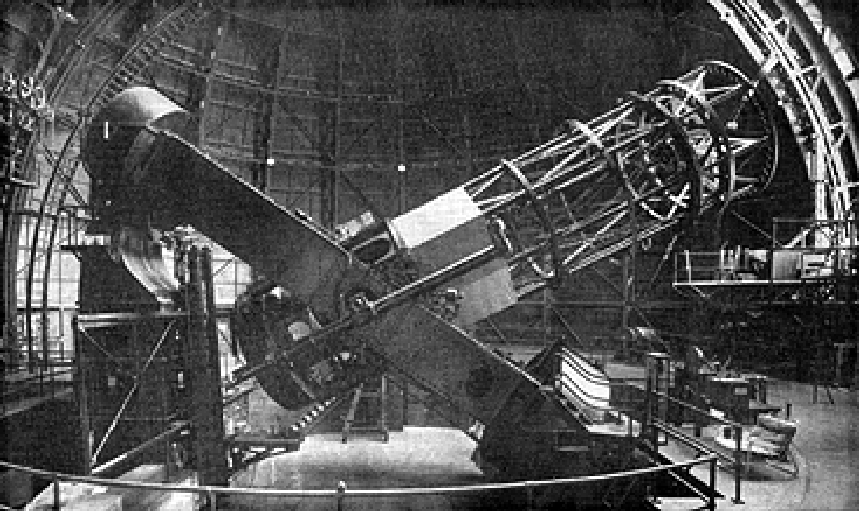 inch
Hooker
reflector on Mount Wilson, and realised that galaxies generally appeared
to be moving away from us. Their recession velocity caused a shift in the
spectrum of light towards redder colours - analogous to the Doppler shift
in the pitch of an ambulance siren as it passes by - and is known as the
redshift.
Cosmologists proposed that the redshift of galaxies was due not to their
motions through space, but rather to the expansion
of space itself - a dramatic conclusion, but one which is nonetheless in
agreement with the predictions of the 'Big Bang' theory for the origin
of the Universe, and Einstein's (pictured third from right, above) general
theory of relativity.
inch
Hooker
reflector on Mount Wilson, and realised that galaxies generally appeared
to be moving away from us. Their recession velocity caused a shift in the
spectrum of light towards redder colours - analogous to the Doppler shift
in the pitch of an ambulance siren as it passes by - and is known as the
redshift.
Cosmologists proposed that the redshift of galaxies was due not to their
motions through space, but rather to the expansion
of space itself - a dramatic conclusion, but one which is nonetheless in
agreement with the predictions of the 'Big Bang' theory for the origin
of the Universe, and Einstein's (pictured third from right, above) general
theory of relativity.
 Hubble's
law states that the recession velocity (or equivalently the redshift)
of a galaxy is proportional to its distance, and the constant of proportionality
- known today as the Hubble constant - measures the present expansion rate
of the Universe. Today, more than seventy years after Hubble's original
work, cosmologists still debate the precise value of the Hubble constant
- although the launch of the Hubble
Space Telescope, and the work of the HST Distance
Scale Key Project, has led to a wide degree of consensus. The Hubble
constant can also now be measured from data on even larger scales, by studying
the microwave background and gravitational
lenses, yielding results consistent with traditional "standard candle"
methods.
Hubble's
law states that the recession velocity (or equivalently the redshift)
of a galaxy is proportional to its distance, and the constant of proportionality
- known today as the Hubble constant - measures the present expansion rate
of the Universe. Today, more than seventy years after Hubble's original
work, cosmologists still debate the precise value of the Hubble constant
- although the launch of the Hubble
Space Telescope, and the work of the HST Distance
Scale Key Project, has led to a wide degree of consensus. The Hubble
constant can also now be measured from data on even larger scales, by studying
the microwave background and gravitational
lenses, yielding results consistent with traditional "standard candle"
methods.
The
Runaway Universe
Recently, cosmologists have switched
focus from measuring the present expansion rate of the Universe to determining
the expansion rate in the very distant past. These observations can tell
us whether the Universe is speeding up or slowing down - a question closely
related to  the
curvature
of space - and so predict whether or not the expansion of the Universe
will continue forever. We can determine the expansion rate when the Universe
was around half its present age by measuring the distances of supernovae
observed at high redshift, and comparing their estimated distance with
the predicted distance in model Universes with different curvature. Two
research groups (the Supernova
Cosmology Project and SN
High-z Team) have both reached the startling conclusion that the Universe
is accelerating, so that the expansion will indeed continue
the
curvature
of space - and so predict whether or not the expansion of the Universe
will continue forever. We can determine the expansion rate when the Universe
was around half its present age by measuring the distances of supernovae
observed at high redshift, and comparing their estimated distance with
the predicted distance in model Universes with different curvature. Two
research groups (the Supernova
Cosmology Project and SN
High-z Team) have both reached the startling conclusion that the Universe
is accelerating, so that the expansion will indeed continue 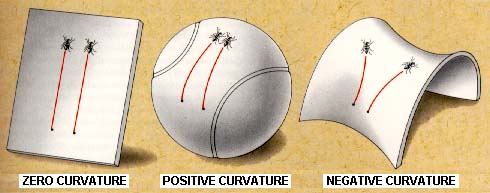 forever.
The energy driving the acceleration appears to come from fluctuations in
the vacuum of space itself - which somewhat resurrects the idea of a "cosmological
constant" proposed, but later rejected, by Einstein himself. Studies of
the microwave background confirm the existence
of this vacuum energy, and suggest that the Universe has zero curvature
- which means its geometry is essentially the same as a flat piece of paper.
Now cosmologists are working hard to understand more clearly what is the
precise nature of the vacuum energy driving the acceleration of the Universe.
forever.
The energy driving the acceleration appears to come from fluctuations in
the vacuum of space itself - which somewhat resurrects the idea of a "cosmological
constant" proposed, but later rejected, by Einstein himself. Studies of
the microwave background confirm the existence
of this vacuum energy, and suggest that the Universe has zero curvature
- which means its geometry is essentially the same as a flat piece of paper.
Now cosmologists are working hard to understand more clearly what is the
precise nature of the vacuum energy driving the acceleration of the Universe.
 changing
their size and intrinsic brightness over a period ranging from a few days
to a few weeks. In the early 1900s Henrietta Leavitt
studied
changing
their size and intrinsic brightness over a period ranging from a few days
to a few weeks. In the early 1900s Henrietta Leavitt
studied  Cepheids
in the Large Magellanic Cloud (the small satellite
galaxy of the Milky Way) and found a relationship between their period
and the luminosity. This meant that, simply by measuring the period of
a more distant Cepheid, astronomers could immediately determine its luminosity
- and hence its distance. Now, almost a century later, Cepheids remain
the backbone of the cosmological distance scale. The Hubble
Space Telescope can observe Cepheids in galaxies many tens of millions
of light years away, such as the giant Spiral galaxy M100
in the Virgo Cluster. (The images below show some Cepheids in M100). During
the past decade the HST Distance
Scale Key Project has used Cepheids to map out our "Local Neighbourhood"
of the Universe.
Cepheids
in the Large Magellanic Cloud (the small satellite
galaxy of the Milky Way) and found a relationship between their period
and the luminosity. This meant that, simply by measuring the period of
a more distant Cepheid, astronomers could immediately determine its luminosity
- and hence its distance. Now, almost a century later, Cepheids remain
the backbone of the cosmological distance scale. The Hubble
Space Telescope can observe Cepheids in galaxies many tens of millions
of light years away, such as the giant Spiral galaxy M100
in the Virgo Cluster. (The images below show some Cepheids in M100). During
the past decade the HST Distance
Scale Key Project has used Cepheids to map out our "Local Neighbourhood"
of the Universe.





 the
the
 forever.
The energy driving the acceleration appears to come from fluctuations in
the vacuum of space itself - which somewhat resurrects the idea of a "cosmological
constant" proposed, but later rejected, by Einstein himself. Studies of
the
forever.
The energy driving the acceleration appears to come from fluctuations in
the vacuum of space itself - which somewhat resurrects the idea of a "cosmological
constant" proposed, but later rejected, by Einstein himself. Studies of
the